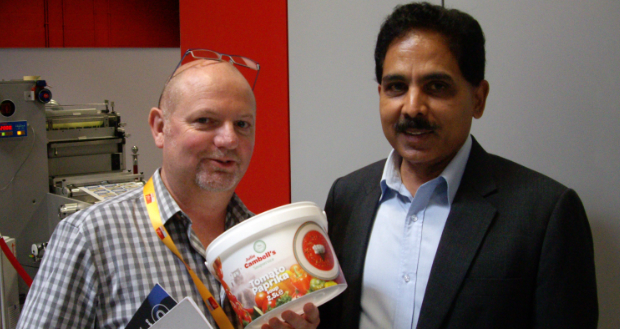
When industry authority and director of business development strategies and custom communications services for InfoTrends, Barbara Pellow strides on to the podium at her company’s October seminars in Sydney and Melbourne, expect some straight talking on the challenges facing the printing industry worldwide and therefore, by inference, in Australasia.
Once and for all, the truism needs to be accepted, she maintains, that no longer is this a commodity oriented manufacturing business. Once and for all, the truism needs to be accepted that the industry needs to transform itself into a resource to help clients more effectively communicate marketing and business information. To do this positively it needs e-learning on digital colour and customised communications; it needs constantly to update itself on case histories to help print service providers understand the various components of their businesses and build stronger returns on investment.
This, of course, is the nub of the InfoTrends input into the industry, with training content that educates the market on building marketing strategies, effectively identifying target markets, pricing models and staffing for digital print operations. Pellow refers to it as “e-enabling” business, developing multi-channel communications, and implementing TransPromo.
“These value-added differentiators are critical to the success of print service providers,” she insists.
Business growth strategies
Reliance on print-only efforts is likely to fall short of the mark, Pellow points out. Today’s print providers need to reinvent themselves into deliverers of multi-channel communications, she adds, citing a recent InfoTrends Study entitled Multi-Channel Communications and Benchmarking, which identified the average marketer as using 3.7 different media channels to reach a prospect. Marketers also stated that a multi-channel campaign including email, print and personalised landing pages was 35 per cent more effective than a print-only campaign.
Expect a strong Barbara Pellow insistence that today’s service providers can only effectively participate in this rapidly changing multi-channel communications opportunity by a series of business growth strategies which need to include:
- developing internet-enabled strategic sourcing customer programmes that serve small and large businesses;
- leveraging multi-channel communications programmes with demonstrable ROI;
- building B2B and B2C print products (eg, photo books, greeting cards, printed ad specialties);
- focusing on recession-proof markets (eg, healthcare, education, small and medium-sized businesses);
- marketing capabilities through multi-channel techniques to build awareness;
- leveraging lean manufacturing, automation, and digital technologies.
However, none of this can be categorised as the easy roadmap to growth without the application of strict marketing disciplines such as analysis of customers’ business environments to identify target markets and research of specific opportunities to meet customer needs in those identified segments. Once this has been completed, a proper selection of media will be the next step to reaching the target audience and build awareness to precondition prospects for salespeople.
“Print service providers must understand that investments in digital technology will only be successful if they have an effective strategy,” is the Pellow proposition.
Back in her Kodak days, Ms Pellow went out on a limb to predict that the future would see companies and processes integrated into the “digital smart factory”. By that she anticipated that successful graphic communications service providers will become “digitally efficient”, meaning that their processes are completed with the fewest resources in the shortest amount of time.
“Many printers, particularly smaller ones aiming for long-term prosperity, are struggling to reconcile the need to offer customers continually improving and innovative services with the need to increase the efficiencies of their underlying manufacturing operations,” she explained. “They need to offer web-enabled links between suppliers, production processes, customers and business processes. Failure to make these workflow investments today will make it difficult to compete in the future.”
Print is not dead … it is interactive!
On the subject of the future, some Pellow crystalballing reveals that with the increased focus on interactivity and multi-channel communications, marketers will want to integrate online media with documents to enable a cohesive and unified marketing tool.
“At the same time, however, fully executing these multi-channel programmes is often elusive. Although technologies like text messaging, short message codes, and pURLs seem promising, they lack a quick, precise, elegant encoding system efficiently to transport the recipient from paper to an online experience.
“Marketers are beginning to explore QR (Quick Response) codes as the ultimate answer,” she stated, explaining that a QR code is a high-density barcode readable by cell phones and simple PC cams. Recipients can quickly and easily interact with the QR-enabled documents they receive. By simply pointing their camera at the QR symbol, they are instantly connected to a QR-encoded web page, without having to remember or type in numbers and promotional codes – they just point and shoot.
“I firmly believe that the marriage of print, QR codes and mobile technology is the ultimate in multi-channel communications. While some are running away from print and putting all their eggs in the online basket, savvy marketers will consider going offline and getting their brand in front of the consumers on the street.
“They will reach consumers who are unchained from their home computers and connect with them via signage, packaging, interactive magazines and newspapers, catalogues, and direct mail,” she claimed.
“Graphic communications service providers need to realise that print is not dead … it is interactive!”
Comment below to have your say on this story.
If you have a news story or tip-off, get in touch at editorial@sprinter.com.au.
Sign up to the Sprinter newsletter



